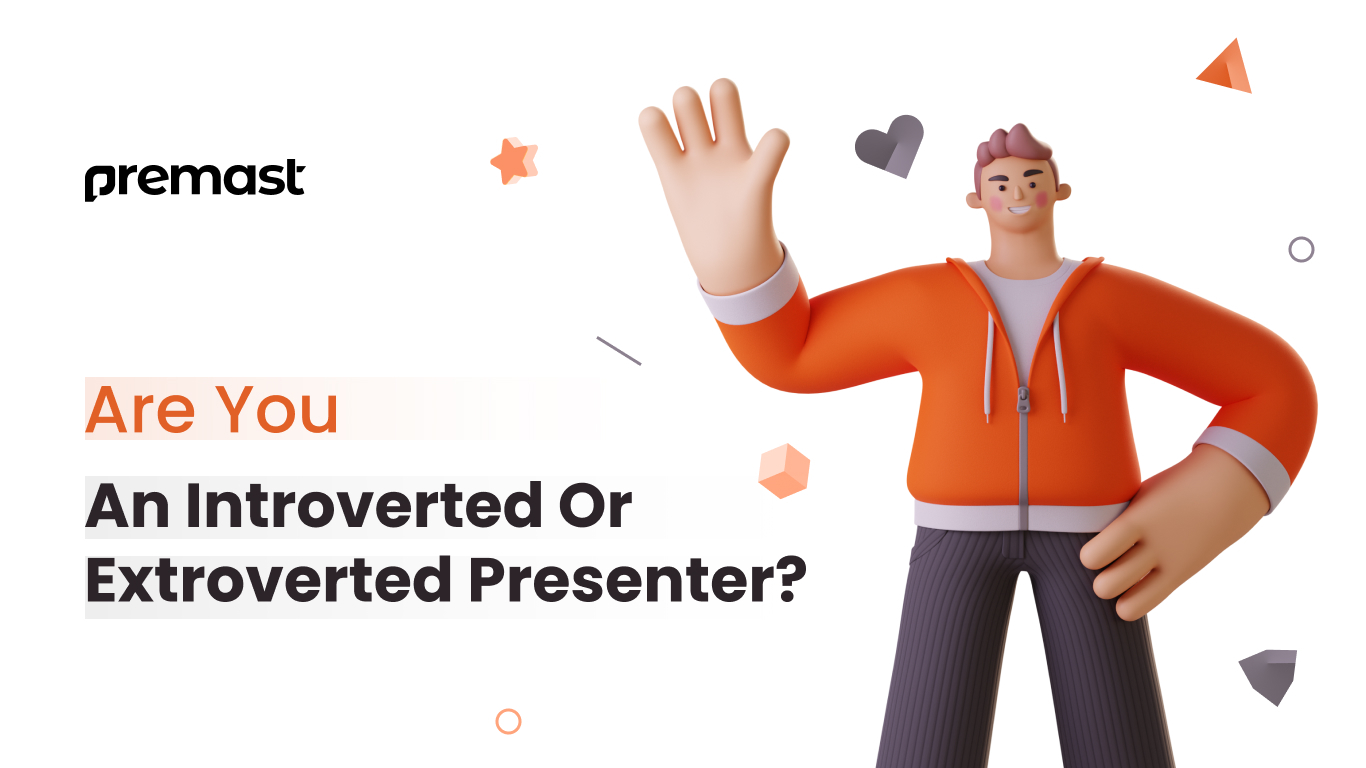learning presentation
Are you an Introverted or Extroverted Presenter?

Firstly, why are we discussing introvert vs. extrovert presenters? Does your personality impact how well you perform during a presentation?
It involves two aspects: how you deliver your message and how the audience receives it. Both personality types have their strengths and weaknesses.
You will learn here how to enhance your presentation skills based on your personality. Are you an introvert or an extrovert? And how can you improve? Let’s begin!”
How does an Introvert person differ from an Extrovert person?
“introvert” and “extrovert” describe how individuals perceive themselves and interact with the world around them.
The primary distinction between introvert and extrovert presenters lies in their preferred ways of spending time.
According to Very Well Mind, people tend to lean towards introversion or extroversion due to two main factors: genetics and environment.
Genetics plays a significant role in determining extroversion, accounting for 40% to 60% of the variability observed in twin studies between extroverted and introverted individuals.
On the other hand, research on siblings conducted in 2011 suggests that individual experiences carry more influence than shared experiences within a family, highlighting the impact of the environment on a person’s introverted or extroverted tendencies.
Someone could be an introvert if:
- They find pleasure in solitary moments.
- They prioritize intimate interactions with a few individuals over larger social gatherings.
- They require downtime to recuperate and replenish their energy levels following a hectic workday or period of intense activity.
- They tend to delve into their thoughts and require ample time to ponder and analyze various matters.
Someone could be an extrovert if:
- They enjoy being around people and don’t like being alone sometimes.
- They love being in crowded places, attending parties, and being part of gatherings with new people.
- Being with others helps them recharge their energy.
- They are outgoing, talkative, and enjoy being the center of attention.
What are the differences in presentation style between an introverted person and an extroverted person?
Every presenter consists of a mix of introverts and extroverts, who have their ways of thinking and expressing themselves.
They both desire to connect and involve the audience in their presentations.
When it comes to the content of their presentations, the disparities between the two types of presenters are somewhat negligible.
Most of the information they provide is similar.
However, if we examine the details closely, we may observe that extroverts tend to dominate the stage and engage the audience more.
If we completely overlook the details, introverts may struggle to establish themselves as reliable and excellent presenters.
However, if we strike a balance by explaining, storytelling, and maintaining a suitable pace, both personality types are likely to perform well.
To truly understand the impact of this personality difference, we need to explore their presentations when they become interactive and require audience feedback and involvement.
Once again, extroverts thrive on personal energy, while introverts derive more mental or physical energy from their thoughts and reflections.
This does not mean that introverts are shy or anti-social, nor does it imply that extroverts are self-centered. Extroverts find stimulation in their surroundings.
Being in front of an audience naturally energizes them. Conversely, introverts manage their energy by looking inward and reflecting on their thoughts.
In summary, we have delved into two comprehensive explanations highlighting the disparities between introvert and extrovert presenters.
Introvert Presenter:
Introverted individuals often make up for their unease with verbal communication by producing highly refined, elaborate, and precise design deliverables. They tend to address every possible scenario and variation, such as clear user paths, flawless wireframes, and comprehensive sitemaps. In summary, they incorporate all the necessary information and encompass all technical explanations.
Let’s explore the three main advantages that introverts offer during a presentation:
- By diligently addressing numerous details, introverts minimize the likelihood of encountering technical queries.
- Introverts possess a natural inclination towards thorough preparation, which enhances their effectiveness.
- Introverts have increased opportunities for active listening and personal disclosure at a later stage. They are not inclined towards small talk; rather, they focus on delving into the core of discussions.
Introverts tend to reflect before speaking and reserve their opinions until they have had sufficient time to contemplate them thoroughly.
Weakness that introverted presenters might experience are:
- Presentations have too much information on many slides, causing people in the room to focus on different parts of what’s being shown.
As a result, individuals may end up questioning things that have already been explained, which is not ideal for introverted individuals who prefer clear and straightforward presentations.
Advice for introverts:
Still worried about giving a presentation to a group? Here are some tips you can try:
- Put the audience first
The needs of our audience are important for both introverts and extroverts. Focus on what can help make things easier for us. When talking to them, try to be conversational, ask questions that meet their needs, and stay on topic. Remember this when creating content and practicing our speech. It can help reduce worries about being the center of attention.
- Act confident
Start with a big smile and positive words to boost our confidence. Many famous introverted performers, like singers, comedians, and actors, have learned to create a different identity on stage. It’s like wearing a mask.
- Get the audience on your side
Introverts, who are more inward-focused, may feel disconnected from large crowds. To feel more at ease during the rest of our speech, it’s helpful to establish a connection with the audience. When introverts step on stage, they can warm up to the audience by silently thinking through different problems, solutions, and scenarios. Start with a joke, story, or something that gets a physical reaction from the audience. If we’re introverts, we might feel uncomfortable or extremely scared about public speaking. But it’s important to know that these fears are normal, and being introverted can be an advantage in becoming a great presenter.
Extrovert Presenter:
Extroverts have communication abilities have the ability to attract people’s attention effectively. Their presentation slides are often more impactful, and concentrated, and serve as better reminders for the presenter, helping them align with the narrative they aim to convey. Consequently, they engage the audience more effectively and draw their attention to the story presented during the meeting.
Three main advantages that Extroverts offer during a presentation:
- Extroverted storytellers possess the skill to craft narratives that resonate with the audience, making it easier for them to connect with the challenges and solutions presented.
- Their natural social confidence and affinity for conversation contribute to a captivating and engaging stage presence.
- Being adept at communication, extroverts can effectively convey their message, leaving a lasting impact on the audience and exerting influence or persuasion.
Extroverts often speak their thoughts as they come to mind, without overthinking. Their words may not be their final opinion, but just how they’re processing ideas. If you ask extroverts for their views, they’ll likely start talking without hesitation.
Weakness that extroverted presenters :
- As an extroverted presenter, we’ll concentrate on humanizing the story rather than highlighting technical details. This may lead to a vague understanding of how certain functionalities will work, as we’ll be emphasizing a less impressive point instead of the good points.
Here are three helpful suggestions for extroverted presenters:
- Inquire and interact with the audience.
Prioritize their involvement over a one-sided performance by seeking their input, allowing them time to express their thoughts on relevant topics.
We’ll be proactive in our approach, encouraging participation, and extroverted attendees will likely be enthusiastic about contributing to a dynamic conversation rather than a passive lecture.
In case a formal Q&A session isn’t part of our speech, we can employ rhetorical questions to prompt contemplation and invite them to engage with us afterward to share their perspectives.
- Using strategic pauses:
Sometimes, the influence of others’ energy can make us overly enthusiastic, causing us to rapidly switch between topics or speak too quickly.
To maintain a more balanced and controlled pace during our presentation, it’s beneficial to incorporate intentional pauses. Alternatively, we can explore the idea of practicing with a metronome to prevent excessive word overflow.
- Practice a lot:
Sometimes we feel comfortable just winging it and taking risks when giving a speech or presentation.
But that’s a big mistake! Instead, let’s imagine we’re more introverted and prepare ourselves mentally before going on stage.
Whether we’re more quiet or outgoing, it’s essential to know where we stand on the introvert-extrovert scale to be well-prepared for the speech.
Being an Introvert vs. Extrovert presenter will make no difference in being a good presenter. Here are the three main reasons:
1- Our skills and actions are not determined by whether we are extroverted or introverted.
Whether you’re an introvert or extrovert, with the right training and support, anyone can learn to give powerful presentations. Just being outgoing doesn’t automatically make someone a better speaker; in fact, it can lead to disorganization. The real secret to success is mastering public speaking through practice and preparation.
2- Introverted and extroverted presenters have different ways of making presentations, but this doesn’t mean one is better than the other—just that they have unique approaches.
There isn’t one fixed way of delivering a presentation. Different styles have varying degrees of appeal to different audiences. It is crucial to consider the type of audience we are addressing.
The key lies in being authentic and sincere when we speak, by sharing our values, perspectives, expertise, and sensitivities
3- Presenters, whether extroverted or introverted, use different resources and face other challenges.
Extroverts like being in big groups, and they’re good at handling Q&A because they can think on their feet. However, they should sometimes pay more attention to what they say. On the other hand, Introverts tend to focus on individuals, making it easier for them to connect with their audience and be charismatic speakers. They also prepare well in advance for any possible questions they might face, ensuring they know exactly what to say when called upon.
How do you create a balance in a presentation with two different personas?
We can’t make someone be someone they’re not. For example, trying to force quiet people to become talkative or vice versa won’t work.
A better approach is to know yourself and what you’re good at, and then compare yourself to others. Recognize your strengths and work on your weaknesses.
If you’re in a team, try to have a mix of introverts and extroverts. It may not be easy, but the differences in personalities can improve everyone’s skills.
Don’t be afraid to accept advice and criticism. See them as opportunities to get better and leave your ego aside.
Exploring Introvert and Extrovert Presenters: Finding Balance and Avoiding the Middle Ground?
Every individual has an equal opportunity to become a presenter, regardless of their personality. But do you know what else is vital besides your skills and the content of your presentation? It’s how you design your slides – trust me, visuals play a crucial role. According to Splento, visual content not only captures attention but also serves as a powerful tool for helping your audience comprehend your message better. A significant majority of people are visual learners, with Forbes reporting that 65% of us fall into this category. Given that 90% of information transmitted to the brain is visual, using visuals in your presentation significantly increases the effectiveness of conveying your message.
Conclusion:
Identify what makes you fear and name it.
Then, talk to yourself using words like “you” or “he/she” before going on stage.
Sometimes, small changes can help reduce the stress of giving a presentation in front of others.
Being true to yourself is the key to giving a great presentation, whether you’re an introvert or an extrovert. It doesn’t mean extroverts are always better presenters.
You can enrich your presentation journey to feel more professional & comfortable by visiting “Premast” to download more PowerPoint presentation Templates with many categories.
Leave a Reply
You must be logged in to post a comment.





Leave a Reply
You must be logged in to post a comment.